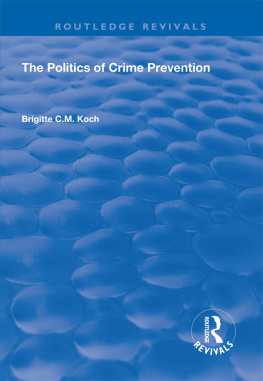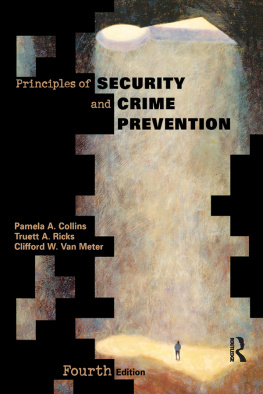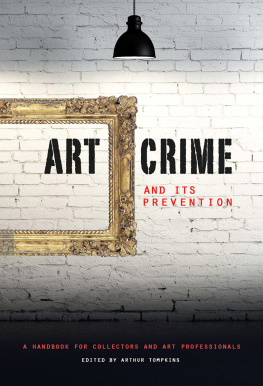Rebuilding Crime Prevention Through Environmental Design
Crime Prevention Through Environmental Design (CPTED) is a practice-oriented approach to reduce the risk of offences such as burglary and fear of crime by modifying the built environment. In recent years, this approach has been criticised for confused terminology and for failing to integrate successfully with other approaches.
Rebuilding Crime Prevention Through Environmental Design explores and extends the common ground between CPTED and situational crime prevention another traditional approach in the field of crime prevention and security via the latters evolution into the field of crime science. Drawing on international research to develop new interdisciplinary perspectives, this volume explores how situational crime prevention and environmental criminological theories relate to those of Crime Prevention Through Environmental Design and considers how crime science can be reformulated to merge different approaches, or at least articulate them better.
Rebuilding Crime Prevention Through Environmental Design will appeal to students, applied academic researchers and practitioners who wish to deepen their understanding and contribute in turn to the ongoing revitalisation of the field.
Rachel Armitage is Professor of Criminology within the School of Human and Health Sciences at the University of Huddersfield, UK.
Paul Ekblom is Emeritus Professor of Design Against Crime at Central Saint Martins, University of the Arts London, UK; and Visiting Professor at both UCL and the University of Huddersfield, UK.
Crime Science Series
Edited by Richard Wortley
UCL
Crime science is a new way of thinking about and responding to the problem of crime in society. The distinctive nature of crime science is captured in the name.
First, crime science is about crime. Instead of the usual focus in criminology on the characteristics of the criminal offender, crime science is concerned with the characteristics of the criminal event. The analysis shifts from the distant causes of criminality biological makeup, upbringing, social disadvantage and the like to the near causes of crime. Crime scientists are interested in why, where, when and how particular crimes occur. They examine trends and patterns in crime in order to devise immediate and practical strategies to disrupt these patterns.
Second, crime science is about science. Many traditional responses to crime control are unsystematic, reactive and populist, too often based on untested assumptions about what works. In contrast, crime science advocates an evidence-based, problem-solving approach to crime control. Adopting the scientific method, crime scientists collect data on crime, generate hypotheses about observed crime trends, devise interventions to respond to crime problems and test the adequacy of those interventions.
Crime science is utilitarian in its orientation and multidisciplinary in its foundations. Crime scientists actively engage with front-line criminal justice practitioners to reduce crime by making it more difficult for individuals to offend, and making it more likely that they will be detected if they do offend. To achieve these objectives, crime science draws on disciplines from both the social and physical sciences, including criminology, sociology, psychology, geography, economics, architecture, industrial design, epidemiology, computer science, mathematics, engineering and biology.
Realist Evaluation for Crime Science
Essays in Honour of Nick Tilley
Edited by Graham Farrell and Aiden Sidebottom
Rebuilding Crime Prevention Through Environmental Design
Strengthening the Links with Crime Science
Edited by Rachel Armitage and Paul Ekblom
For more information about this series, please visit: www.routledge.com/criminology/series/CSCIS
Rebuilding Crime Prevention Through Environmental Design
Strengthening the Links with Crime Science
Edited by Rachel Armitage and Paul Ekblom
First published 2019
by Routledge
2 Park Square, Milton Park, Abingdon, Oxon OX14 4RN
and by Routledge
52 Vanderbilt Avenue, New York, NY 10017
Routledge is an imprint of the Taylor & Francis Group, an informa business
2019 selection and editorial matter, Rachel Armitage and Paul Ekblom; individual chapters, the contributors
The right of Rachel Armitage and Paul Ekblom to be identified as the authors of the editorial material, and of the authors for their individual chapters, has been asserted in accordance with sections 77 and 78 of the Copyright, Designs and Patents Act 1988.
All rights reserved. No part of this book may be reprinted or reproduced or utilised in any form or by any electronic, mechanical, or other means, now known or hereafter invented, including photocopying and recording, or in any information storage or retrieval system, without permission in writing from the publishers.
Trademark notice: Product or corporate names may be trademarks or registered trademarks, and are used only for identification and explanation without intent to infringe.
British Library Cataloguing-in-Publication Data
A catalogue record for this book is available from the British Library
Library of Congress Cataloging-in-Publication Data
A catalog record for this book has been requested
ISBN: 978-1-138-91963-1 (hbk)
ISBN: 978-1-315-68777-3 (ebk)
Typeset in Times New Roman
by Apex CoVantage, LLC
Contents
Paul Ekblom and Rachel Armitage
Michelle Rogerson and Ken Pease OBE
Rachel Armitage and Chris Joyce
Danielle M. Reynald and Mateja Mihinjac
Paul Ekblom
Daniel Birks and Joseph Clare
Herv Borrion, Octavian Ciprian Bordeanu and Sonia Toubaline
Massoomeh Hedayati Marzbali, Aldrin Abdullah and Mohammad Javad Maghsoodi Tilaki
Ward A. Adams, Eric S. McCord and Marcus Felson
Leanne Monchuk
Marcus Willcocks, Paul Ekblom and Adam Thorpe
Rachel Armitage and Paul Ekblom
7.5Normalised consequences of (as,CF/aVK7CF) associated with attack plans VK8 and VK11, for different positions of the armed response vehicle (0: no ARV)
Contemporary politics is trapped in short-termism and parties may never be able to recover.1 Substitute policy for politics and society for parties and the sentiment remains true. In essence, we campaign and vote driven by a blend of our own interests and those of our children and grandchildren. Self-interest almost always means that the former prevails. The construction of places channels human behaviour, often for generations. This is true of both physical space and (in a different way) cyberspace. Design and construction remaining mindful of issues like energy expenditure, carbon cost and crime are like voting in the interests of your grandchildren.
The aim of CPTED is self-evidently worthy in striving for a reduced-crime world for our children to inherit. Where an aim is worthy, application typically outruns evidence. The editors stated aspiration is to take a bulldozer to CPTEDs wobbly edifice and reinforce its foundations. The contributions represent many possible approaches to building on those foundations (the chapters with lead authors Birks and Borrion are to this reader particularly promising).






